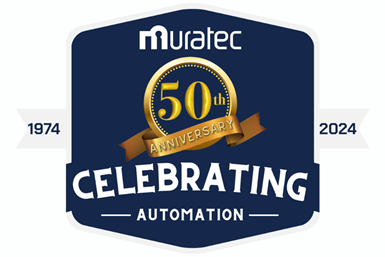Murata Machinery USA Celebrates 50 Years
Muratec’s technology has marked turning points in automation, helping customers enhance competitive efficiencies across diverse industries.
Share


Autodesk, Inc.
Featured Content
View More
ECi Software Solutions, Inc.
Featured Content
View More



Takumi USA
Featured Content
View More
Hwacheon Machinery America, Inc.
Featured Content
View MoreMurata Machinery USA (Muratec) commemorates its 50th anniversary with various activities planned across North America throughout 2024. Operating as a subsidiary of Kyoto, Japan-based Murata Machinery Ltd., Murata Machinery USA provides sales, service and support for the Muratec brand.
In May 1974, Murata Machinery Ltd. established Murata of America Inc. in Charlotte, North Carolina, initially focusing on textile machinery. In October 1989, it acquired the Wiedemann Division from the Warner & Swasey Company, creating Murata Wiedemann Inc. The unified brand “Muratec” was introduced in October 1991. By June 2002, the company consolidated its U.S. subsidiaries, Murata of America Inc. and Murata Wiedemann Inc., into Murata Machinery USA Inc. Throughout North America, Muratec expanded its automation portfolio to encompass material handling, machine tools, fabrication technology and cleanroom automation solutions, showcasing a broadened range of offerings.
Muratec says its innovations over the last 50 years have marked turning points in automation, helping customers enhance their competitive efficiencies across diverse industries. Some of these automation advances include:
- Logistics and automation: In the 1990s, Muratec advanced North American automotive stamping with an integrated turnkey solution, combining die handling, blank processing, stamping, warehousing and transport control. This streamlined processes and minimized waste by integrating automated storage and retrieval systems (ASRS) and automated guided vehicles (AGV), reshaping the automotive sector’s logistics and material handling approach. Muratec’s automation systems cover high-rise warehouses, unmanned transporting systems, robotic automation and factory automation.
- Clean factory automation: Muratec’s floor and overhead transport systems are designed to optimize fabrication processes, maximize space and ensure product integrity with minimal vibration. These solutions set industry benchmarks that readily interface with customer manufacturing execution systems and tools. Muratec is said to be one of the world’s largest semiconductor clean-room automated manufacturers.
- Machine Tools Division (MTD): In 1980, Muratec introduced its MW25, the inaugural twin-spindle automated chucker lathe that seamlessly integrated automation with a gantry loader, an industry-first according to the company. Then, in 1994, Muratec invented the world’s first electric servo motor CNC turret punch press. The Motorum 2000 featured an eco-friendly design, low noise and highly productive, hydraulic, oil-less operation. Muratec’s machine tools, spanning turning, sheet metal fabrication and automated handling systems combine high speed and precision.
“Murata Machinery USA has been a beacon of excellence, driving industrial innovation and achieving continental success,” says Toshiyuki Komori, president and CEO, Murata Machinery USA. “Unwavering in our commitment, we aim to propel the Muratec brand of end-to-end automation to new heights across North America, helping customers maintain their competitive edge with automation.”
In 2024, Muratec will mark 50 years of automation innovation with initiatives. In September, the company will introduce new machinery, along with 10 machine demonstrations, at IMTS 2024.
Related Content
-
Translating a Prototyping Mindset to Production
The experimental mindset that benefited BDE Manufacturing Technologies as a prototype job shop has given it an adaptable edge as a production facility.
-
Cutting Part Programming Times Through AI
CAM Assist cuts repetition from part programming — early users say it cuts tribal knowledge and could be a useful tool for training new programmers.
-
Investing in Automation, Five-Axis to Increase Production Capacity
To meet an increase in demand, this shop invested heavily in automation solutions and five-axis machines to ramp up its production capabilities.



































.jpg;maxWidth=300;quality=90)




